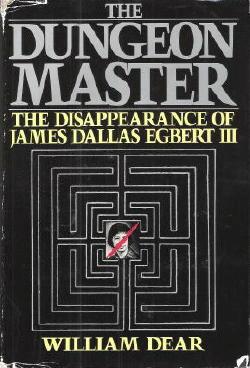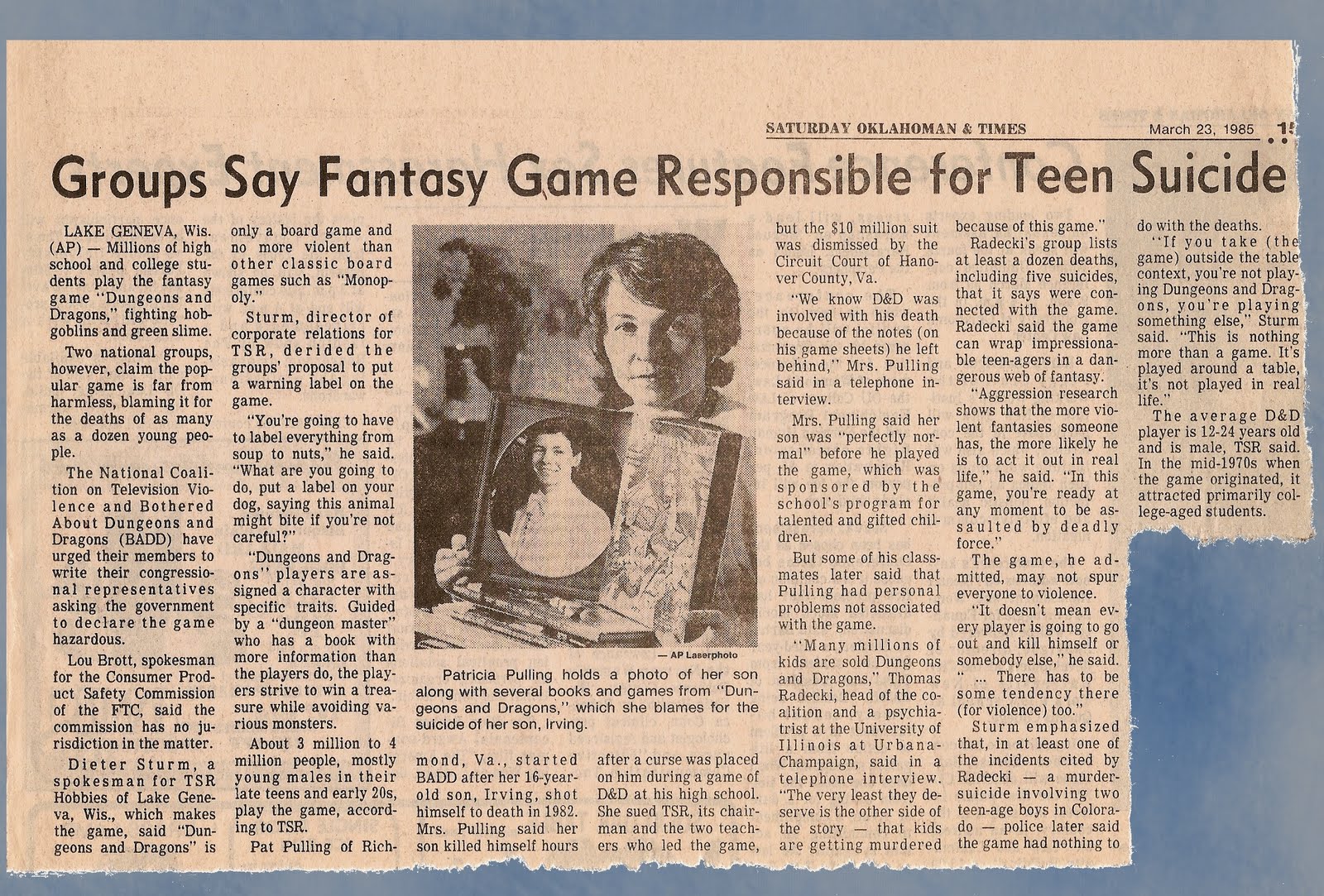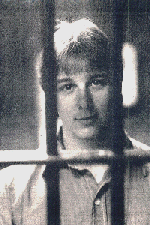Controversy: The Attacks and The Truth
A Brief History of Attacks
Because D&D is the oldest of modern RPGs, it is frequently, specifically attacked, but the attacks themselves are applied to RPGs universally. The first big scare occurred in 1979, when James Dallas Egbert III disappeared from Michigan State University. When police investigation found no evidence suggesting foul play, his family hired a private investigator named William Dear, which caused the situation to rapidly devolve. In his 1994 article, “The Attacks on Role-Playing Games,” published in Skeptical Inquirer, Paul Cardwell examines Dear’s work thoroughly. Through second- and third-hand information, Dear determined that Egbert was a strange young man with a strange hobby: playing D&D in the steam tunnels of MSU. He decided that Egbert must have gotten lost in the steam tunnels while playing D&D with a fake broadsword, a sum of misconceptions that he then published in a book.[1] The New York Times reported in August 1980 that Egbert committed suicide by gunshot almost a year after having been found.[2]
Then, in 1982, the storm that had been brewing for two years was unleashed when Irving (Bink) Pulling II committed suicide with his mother’s pistol.[3] Daniel Martin and Gary Fine, in their 1991 article, “Satanic Cults, Satanic Play,” discuss in detail how the suicide of this one boy generated decades of controversy. Bink had played D&D through a class at school, and his mother, Patricia, claimed that his teacher had cursed him to become a homicidal killer, but that he had righteously taken his own life in order to spare others.[4] Patricia Pulling then formed the organization Bothered About Dungeons & Dragons (BADD), modeled off of Mothers Against Drunk Driving, which provided source material for anti-RPG groups.[5] This group led the charge against role-playing games alongside the National Coalition on Television Violence, demanding warning labels on the games stating that they may lead to suicide, and even going so far later as to claim that they lead to Satanism[6], and murder.[7]
Then, in 1982, the storm that had been brewing for two years was unleashed when Irving (Bink) Pulling II committed suicide with his mother’s pistol.[3] Daniel Martin and Gary Fine, in their 1991 article, “Satanic Cults, Satanic Play,” discuss in detail how the suicide of this one boy generated decades of controversy. Bink had played D&D through a class at school, and his mother, Patricia, claimed that his teacher had cursed him to become a homicidal killer, but that he had righteously taken his own life in order to spare others.[4] Patricia Pulling then formed the organization Bothered About Dungeons & Dragons (BADD), modeled off of Mothers Against Drunk Driving, which provided source material for anti-RPG groups.[5] This group led the charge against role-playing games alongside the National Coalition on Television Violence, demanding warning labels on the games stating that they may lead to suicide, and even going so far later as to claim that they lead to Satanism[6], and murder.[7]
The truth of the matter is, players of RPGs are no more susceptible to emotional instability than any other group of people, as found in Armando Simón’s 1987 study, and backed up by a more recent 1998 study conducted by Carter & Lester.[13]
Playing role-playing games does not appear to correlate in any way with the rate of suicide. B.A.D.D. provided a list of suicide cases that they claimed were caused by Dungeons & Dragons, but few of the cases were properly cited for reference. Cardwell points out that of the nine cases they claimed, one was an accident, and three were disputed by the victims’ parents who claimed that D&D had nothing to do with their deaths.[14] Stackpole discusses 125 cases presented by Patricia Pulling in her book, "The Devil's Web," stating that "(g)iven that the 125 cases cited above consist of roughly 50% murders and 50% suicides, the statistics
cast even more doubt on the link between games and suicide."[15]
Martin & Fine suggest that it is also very possible that involvement in role-playing games has actually prevented many suicides,[16] a charge supported by Stackpole, who points out that suicide rates during 1980 were lower than they'd been for years, and continued to decline over the decade.[17] Stackpole's work "Game Hysteria and the Truth," discusses a number of studies conducted by the Center for Disease Control, the American Association of Suicidology, the spokesperson for the Associated Gifted and Creative Children of California, and Dr. S. Kenneth Schonberg of the Albert Einstein College of Medicine in New York, none of which found any correlation between suicide and involvement in Dungeons & Dragons. Further, he goes on to dispute the statistic evidence presented by Pullman herself, stating that her numbers actually suggest participants are less likely to attempt to commit suicide, let alone succeed, than the general population.[18] Pullman’s own son had a number of issues that likely contributed to his suicide in more significant ways, as evidenced by his tearing apart several pet rabbits and disemboweling a cat.[19]
The stories of Michael Dempsey, David Ventiquattro, and Sean Sellers also had outside factors that influenced their situations. In Dempsey's case, the only witness to his suicide was his father, a man who was strongly against Dungeons & Dragons, and few other details surrounding his suicide have been released.[20] Ventiquattro was testified against by two other young boys, who stated that he had "pointed a gun at them on separate occasions after they had played Dungeons and Dragons with him,"[21] clearly indicating a disturbing pattern of behavior that was unlikely caused by playing a game.
Finally, games themselves are not addictive. Just as Simón found that D&D does not contribute to emotional stability, Kelly 2 discusses how the addiction of gamers is based upon their genetic predispositions to addiction and their personalities.[23] It is important to realize that games of any nature are no more or less addictive than any other leisure activity (sports, for instance). This isn’t to say that addiction doesn’t happen with these games; like every other leisure activity, individuals can become addicted, and serious help should always be sought in those cases.
These studies are just the tip of the iceberg for information on role-playing games, and I encourage everyone to do some research of their own. When one considers that these myths and the realities behind them apply to all role-playing games, it seems reasonable to conclude that role-playing games offer no danger to our youth of suicide, murder, Satanism, or otherwise.
Foot Notes:
1. Cardwell, 1994, pp. 158-159.
2. Robbins, 1980.
3. Cardwell, 1994, p. 160.
4. Martin & Fine, 1991, p.115.
5. Ibid., p.108; Cardwell, 1994, p.160.
6. Martin & Fine, 1991, pp.114-115; Cardwell, 1994, p. 162.
7. Cardwell, 1994, p.164.
8. The Escapist, As BADD As It Gets, p. 3, accessed November 25, 2012.
9. New York Times, 16-Year Old Is Convicted in Fantasy-Game Slaying of Boy, 11, 1986.
10. Clark Prosecutor.Org, Sean Richard Sellers, accessed November 26, 2012.
11. Cardwell, 1994, p.164-165.
12. Kelly 2, 1994, p.63.
13. Simón, 1987, p.332; Carter & Lester, 1989, p.182.
14. Cardwell, 1994, p.160-161.
15. Stackpole, 1989.
16. Martin & Fine, 1991, p.114.
17. Stackpole, 1989.
18. Ibid.
19. Martin & Fine, 1991, p.115; Cardwell, 1994, p.160.
20. The Escapist, As BADD As It Gets, p. 3.
21.New York Times, 16-Year Old Is Convicted in Fantasy-Game Slaying of Boy, 11, 1986.
22. Clark Prosecutor.Org, Sean Richard Sellers.
23. Kelly 2, 2004, p.67.
Playing role-playing games does not appear to correlate in any way with the rate of suicide. B.A.D.D. provided a list of suicide cases that they claimed were caused by Dungeons & Dragons, but few of the cases were properly cited for reference. Cardwell points out that of the nine cases they claimed, one was an accident, and three were disputed by the victims’ parents who claimed that D&D had nothing to do with their deaths.[14] Stackpole discusses 125 cases presented by Patricia Pulling in her book, "The Devil's Web," stating that "(g)iven that the 125 cases cited above consist of roughly 50% murders and 50% suicides, the statistics
cast even more doubt on the link between games and suicide."[15]
Martin & Fine suggest that it is also very possible that involvement in role-playing games has actually prevented many suicides,[16] a charge supported by Stackpole, who points out that suicide rates during 1980 were lower than they'd been for years, and continued to decline over the decade.[17] Stackpole's work "Game Hysteria and the Truth," discusses a number of studies conducted by the Center for Disease Control, the American Association of Suicidology, the spokesperson for the Associated Gifted and Creative Children of California, and Dr. S. Kenneth Schonberg of the Albert Einstein College of Medicine in New York, none of which found any correlation between suicide and involvement in Dungeons & Dragons. Further, he goes on to dispute the statistic evidence presented by Pullman herself, stating that her numbers actually suggest participants are less likely to attempt to commit suicide, let alone succeed, than the general population.[18] Pullman’s own son had a number of issues that likely contributed to his suicide in more significant ways, as evidenced by his tearing apart several pet rabbits and disemboweling a cat.[19]
The stories of Michael Dempsey, David Ventiquattro, and Sean Sellers also had outside factors that influenced their situations. In Dempsey's case, the only witness to his suicide was his father, a man who was strongly against Dungeons & Dragons, and few other details surrounding his suicide have been released.[20] Ventiquattro was testified against by two other young boys, who stated that he had "pointed a gun at them on separate occasions after they had played Dungeons and Dragons with him,"[21] clearly indicating a disturbing pattern of behavior that was unlikely caused by playing a game.
Finally, games themselves are not addictive. Just as Simón found that D&D does not contribute to emotional stability, Kelly 2 discusses how the addiction of gamers is based upon their genetic predispositions to addiction and their personalities.[23] It is important to realize that games of any nature are no more or less addictive than any other leisure activity (sports, for instance). This isn’t to say that addiction doesn’t happen with these games; like every other leisure activity, individuals can become addicted, and serious help should always be sought in those cases.
These studies are just the tip of the iceberg for information on role-playing games, and I encourage everyone to do some research of their own. When one considers that these myths and the realities behind them apply to all role-playing games, it seems reasonable to conclude that role-playing games offer no danger to our youth of suicide, murder, Satanism, or otherwise.
Foot Notes:
1. Cardwell, 1994, pp. 158-159.
2. Robbins, 1980.
3. Cardwell, 1994, p. 160.
4. Martin & Fine, 1991, p.115.
5. Ibid., p.108; Cardwell, 1994, p.160.
6. Martin & Fine, 1991, pp.114-115; Cardwell, 1994, p. 162.
7. Cardwell, 1994, p.164.
8. The Escapist, As BADD As It Gets, p. 3, accessed November 25, 2012.
9. New York Times, 16-Year Old Is Convicted in Fantasy-Game Slaying of Boy, 11, 1986.
10. Clark Prosecutor.Org, Sean Richard Sellers, accessed November 26, 2012.
11. Cardwell, 1994, p.164-165.
12. Kelly 2, 1994, p.63.
13. Simón, 1987, p.332; Carter & Lester, 1989, p.182.
14. Cardwell, 1994, p.160-161.
15. Stackpole, 1989.
16. Martin & Fine, 1991, p.114.
17. Stackpole, 1989.
18. Ibid.
19. Martin & Fine, 1991, p.115; Cardwell, 1994, p.160.
20. The Escapist, As BADD As It Gets, p. 3.
21.New York Times, 16-Year Old Is Convicted in Fantasy-Game Slaying of Boy, 11, 1986.
22. Clark Prosecutor.Org, Sean Richard Sellers.
23. Kelly 2, 2004, p.67.
The Truth
A Brief History of Attacks

First edition cover of William Dear's book, found at Amazon.com.
Finally, the most recent development in the attacks on role-playing games is the claim that the games themselves are addictive. The advent of Online RPGs has brought with it the perception of an addiction epidemic, which I will discuss the truth of shortly. However, it is easy to see why we perceive this addiction; according to Kelly 2’s 2004 book, “Massively Multiplayer Online Role-Playing Games,” people today are more likely to flee to the virtual world when there is a real-world economic crisis or war, preferring the stability of the online world to the real world.[12]

Saturday Oklahoman & Times news article, March 23, 1985, about BADD and the suicide of Irvng "Bink" Pulling II. Click here to read this article. Found at They Stole Frazier's Brain.
The 1980s were riddled with fear over Satanism, and several suicides and murders were being attributed to Dungeons & Dragons. 1981 saw the suicide of Michael P. Dempsey, who's father claimed to have witnessed the young man attempting to summon demons just before his death.[8] The 1982 release of the film, "Mazes and Monsters," starring Tom Hanks, told the story of Egbert's disappearance in a way that reached more audiences than the books written on the subject could. D&D was claimed to be the cause of David K. Ventiquattro shooting 11-year-old Martin E. Howland in 1985 at the age of 15.[9] In the murder case of Sean Sellers, wherein the 16-year old shot and killed a convenience store clerk several months before shooting and killing his mother and step-father in 1986, the young man originally claimed to have been addicted to Dungeons & Dragons, and later stated that his involvement in the game was the gateway to his practice in Satanism.[10] Claims that participants - particularly young ones - were casting spells and hexes on parents and teachers began to circulate,[11] and only recently have faded out of the mainstream beliefs and superstitions surrounding role-playing games, D&D specifically.
The infamous case of Sean Sellers began when he shot and killed a convenience store clerk because he "wanted to see what it felt like to kill somebody," and then six months later, shot and killed his mother and step-father. First, Sellers claimed that he was addicted to Dungeons & Dragons and had no control over himself, then claimed that he'd killed his victims as a practicing Satanist (made possible by playing Dungeons & Dragons, he claimed), and then again changed his story, claiming to have Multiple Personality Disorder (MPD; though today the disorder is known as Dissociative Identity Disorder). While awaiting the death sentence (Sellers was executed in 1999), he converted to Christianity and began his own ministry from inside of prison, warning people of the dangers of Dungeons and Dragons and it's alleged link to Satanism. However, Sellers also professed to having had a violent childhood, wherein he claimed he was beaten by both his mother and grandfather, and that from early on he began hearing voices. [22] Whether or not Sellers did indeed suffer from DID, his admission to his friend about wanting to know what it felt like to kill, his allegedly violent childhood, and the claim that he was hearing voices from a very young age all paint the portrait of a very disturbed young man who was on a collision course with the law. Given these extenuating circumstances, it seems unlikely that Dungeons & Dragons led him to Satanism as he claimed, or that the game in any way contributed to his killings.

Sean Sellers, found at Clark Prosecuter.